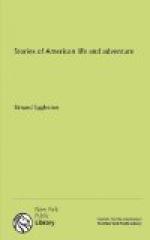At the time that Henry Spelman first went among the Indians, they had no iron tools except a very few that they had bought of the white people. They had no guns, nor knives, nor hatchets. They had no hoes nor axes. They made their tools out of hard wood, shells, stones, deer horns, and other such things. They had not yet bought blankets from the white men, but made their clothes mostly out of the skins of animals.
The Indians could not learn much about the white man’s arts from Spelman, because he did not know much. Besides, he had no iron of which to make tools. He learned to make arrows of cane such as we use for fishing rods. He also learned to point his arrows with the spur of a wild turkey, or a piece of stone. These arrow points he stuck into the arrow with a kind of glue. But he first had to learn how to make his glue out of deers’ horns. Before he could make any of the tools, he had to make himself a knife, as the Indians did. Having no iron, the blade of his knife was made out of a beaver’s tooth, which is very sharp, and will cut wood. He set this tooth in the end of a stick. You see how hard it was for an Indian to get tools. He had to learn to make one tool in order to use that in making another tool.
One of the principal things that an Indian had to do was to make a canoe; for, as the Indians had no horses, they could travel only by water, unless they went afoot. Canoes were the only boats they had. They had to make canoes without any of the tools that white men use. Let us explain this by a story about Henry and an Indian boy. The things in the story may not have happened just as they are told, but the account of how things are made by the Indians is all true.
THE MAKING OF A CANOE.
Henry had a young Indian friend whose name was Keketaw. One day Keketaw said to him, “Let us go into the woods and make a canoe.”
“If we had an ax to cut down the trees,” said the white boy, “or an adz, such as they have at Jamestown, or if we could get a hatchet, we might make a canoe; but we have not even a little knife.”
“We will make a canoe in the Indian way,” said Keketaw. “I will show you how. Let us get ready.”
“What shall we do to get ready?” asked Henry.
“We must take our bows, and we must make many arrows, so as to get something to eat, and we must have fishing lines,” said Keketaw, “or we shall not be able to live in the woods.”
For some days the two boys were getting ready. It took them a long time to scrape a piece of bone into a fishhook by means of a beaver’s tooth set in a stick, but they made three of these hooks. They made some more hooks not so good as these by tying a splinter of bone to a little stick. Keketaw’s mother made fishing lines for them. She took the long leaves of the plant which we call Spanish bayonet, and separated these threads into a hard cord, rubbing them between her hand and her knee.




